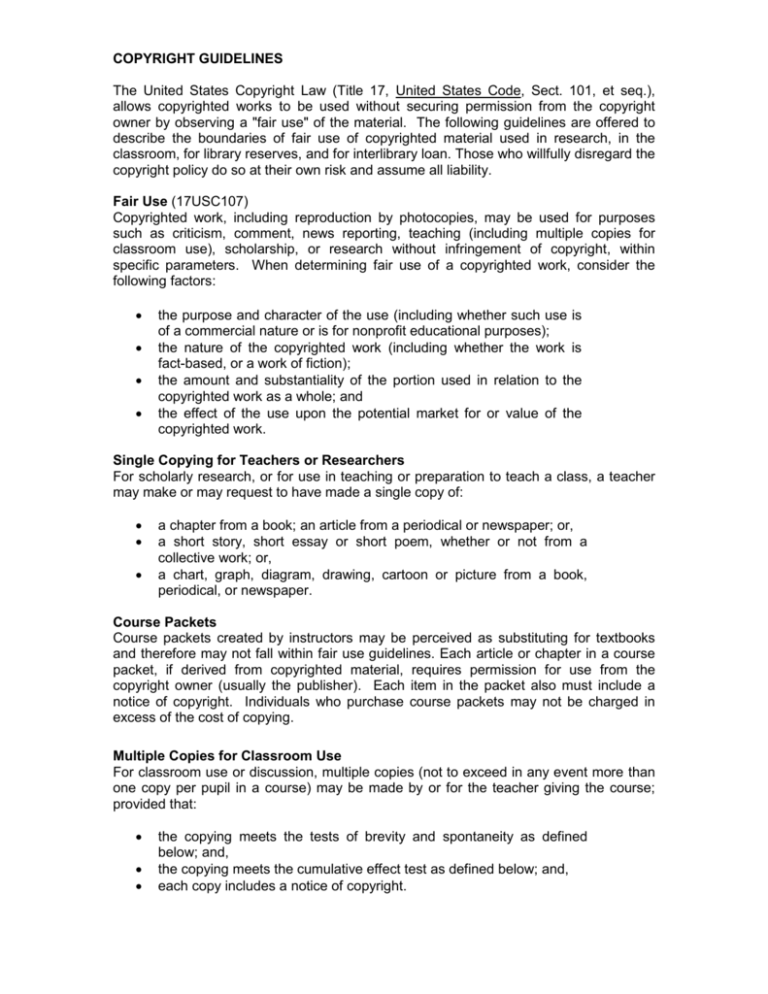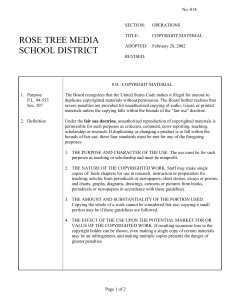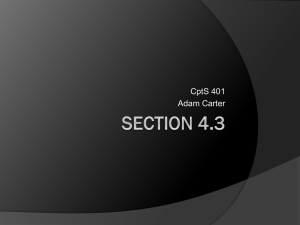Copyright Guidelines
advertisement

COPYRIGHT GUIDELINES The United States Copyright Law (Title 17, United States Code, Sect. 101, et seq.), allows copyrighted works to be used without securing permission from the copyright owner by observing a "fair use" of the material. The following guidelines are offered to describe the boundaries of fair use of copyrighted material used in research, in the classroom, for library reserves, and for interlibrary loan. Those who willfully disregard the copyright policy do so at their own risk and assume all liability. Fair Use (17USC107) Copyrighted work, including reproduction by photocopies, may be used for purposes such as criticism, comment, news reporting, teaching (including multiple copies for classroom use), scholarship, or research without infringement of copyright, within specific parameters. When determining fair use of a copyrighted work, consider the following factors: the purpose and character of the use (including whether such use is of a commercial nature or is for nonprofit educational purposes); the nature of the copyrighted work (including whether the work is fact-based, or a work of fiction); the amount and substantiality of the portion used in relation to the copyrighted work as a whole; and the effect of the use upon the potential market for or value of the copyrighted work. Single Copying for Teachers or Researchers For scholarly research, or for use in teaching or preparation to teach a class, a teacher may make or may request to have made a single copy of: a chapter from a book; an article from a periodical or newspaper; or, a short story, short essay or short poem, whether or not from a collective work; or, a chart, graph, diagram, drawing, cartoon or picture from a book, periodical, or newspaper. Course Packets Course packets created by instructors may be perceived as substituting for textbooks and therefore may not fall within fair use guidelines. Each article or chapter in a course packet, if derived from copyrighted material, requires permission for use from the copyright owner (usually the publisher). Each item in the packet also must include a notice of copyright. Individuals who purchase course packets may not be charged in excess of the cost of copying. Multiple Copies for Classroom Use For classroom use or discussion, multiple copies (not to exceed in any event more than one copy per pupil in a course) may be made by or for the teacher giving the course; provided that: the copying meets the tests of brevity and spontaneity as defined below; and, the copying meets the cumulative effect test as defined below; and, each copy includes a notice of copyright. Definitions Brevity: Type of work Poem less than 250 words Amount of work Complete, but not more than two printed pages Poem 250 words or longer Excerpt of not more than 250 words Article, story, or essay less than 2,500 words Complete Article, story, or essay 2,500 words or longer Lesser amount of either: Excerpt of not more than 1,000 words OR Up to 10% of work Illustration (chart, graph, diagram, drawing, One per book or periodical issue cartoon, picture) Not more than five by one artist, illustrator, or photographer Lesser amount of either: Up to 10% OR not more than 15 images from a published collective work Special works (poetry, prose, or “poetic prose,” Excerpt of not more than two published pages which may combine language with illustrations) AND not more than 10% of words found in text of less than 2,500 words in entirety Music and lyrics from an individual musical Lesser amount of either: work Up to 10% OR not more than 30 seconds Motion media work (e.g., animation, video, or Lesser amount of either: film image Up to 10% OR not more than three minutes Spontaneity: The decision to use the work is so close to the moment of its use for maximum teaching effectiveness that it would be unreasonable to expect a timely reply to a request for permission. Cumulative Effect: (These limitations do not apply to current news articles in periodicals and newspapers.) The copying is for only one course. Not more than one short poem, article, story, essay or two excerpts may be copied from the same author during one class term. Not more than three works from the same collective work or periodical volume may be copied during one class term. There may not be more than nine instances of such multiple copying for one course during one class term. Prohibitions Copies may not be used to create, replace, or substitute for anthologies or collective works, regardless of whether they are accumulated or reproduced and used separately. Works intended to be “consumable,” such as workbooks and test booklets, may not be copied. Copies may not substitute for the purchase of books or periodicals. A teacher may not copy the same item from term to term. Students may not be charged beyond the actual cost of copying. Library Reserves Service The Library routinely accepts single photocopies of copyright-protected chapters, articles, etc. to be used as course reserves, with these considerations: The photocopies are considered to be the instructor's property. The library may reproduce a single copy. An instructor may provide up to three duplicate photocopies when a course is large enough to require more than one of an assigned photocopy. Copyrighted broadcast programs recorded off-air may not be placed on reserve. Fair use factors should be considered to determine the number and nature of photocopies placed on reserve for any given course. Use of Film and Video Productions (17USC110(1)) Video or film productions may be shown by instructors or pupils when they are used: in face-to- face teaching activities of a nonprofit educational institution; and, in a classroom or similar place devoted to instruction; and, using a legitimate (not illegally reproduced) copy with the copyright notice included; and, explicitly to support instruction and the content of the course. Films or videos, even in a "face-to-face" classroom setting, may not be used for entertainment or recreation, whatever the work's intellectual content. Use of Off-Air Broadcast Programs A copyrighted broadcast program may be recorded off-air and temporarily retained by a non-profit educational institution and used for educational purposes within the following parameters, unless a recording, duplication and rebroadcast license has been obtained specifically for that program: Recordings may be retained for a period not to exceed the first fortyfive (45) consecutive calendar days after the date of recording. Recordings may be used once by individual teachers in the course of relevant teaching activities, and repeated once only when instructional reinforcement is necessary. Recordings may be used in a classroom or similar places devoted to instruction during the first ten (10) consecutive schools days in the forty-five (45) day calendar day retention period. Recordings may be made only at the request of and used by individual teachers, and may not be regularly recorded in anticipation of requests. No broadcast program may be recorded off-air more than once at the request of the same teacher, regardless of the number of times the program may be broadcast. Recordings need not be used in their entirety, but they may not be physically or electronically altered, combined, or merged. All copies of off-air recordings must include the copyright notice on the broadcast program as recorded. Transmission of Copyrighted Audio-Visual Material for Distance Learning (17USCS110(2)) The Technology Education and Copyright Harmonization (TEACH) Act regulates the digital transmission of materials to students during classroom-type instruction delivered over the internet. It does not cover materials students may study, read, listen to or watch on their own time outside of class, including electronic reserves. Performance, reading, or display of a non-dramatic literary work (e.g., news article, recitation of a poem or speech) or non-dramatic work of music (e.g., performance) may be transmitted in its entirety. Performance, reading, or display of any other work, such as a dramatic literary work (e.g., film or stage play) or a dramatic musical work (e.g., music video, musical film or theatre, or opera) may be transmitted only in a limited and reasonable amount as determined by fair use guidelines. Commercially produced media must be used in accordance with the terms of the items license agreement. Copyrighted audiovisual material, including audio and video files, and still images, may be transmitted under specific conditions. It is transmitted through a secure, password-protected course management system. It is directly relevant to the teaching content of the course. It is used as part of a regular, systematic, mediated instructional activity. Copyright notice is shown. It is a legally acquired, digital copy. The amount and degree of material used is similar to what would be used in a face-to-face instructional setting. It is not produced or marketed primarily for use in the online distance education market. Students’ ability to retain or further distribute the material is limited by technology. Audio, video, and still images existing only in analog format may be converted to a digital format for use in distance learning instruction under these conditions: A good faith-effort to locate a digital version of the material has been unsuccessful, or the only digital version available is protected by technological measures Only the amount authorized to transmit has been copied Copyright Permission Beyond Fair Use Individuals wishing to use copyrighted works in ways other than those addressed in the fair use guidelines, including but not limited to copying a large portion of a work, copying an entire work, or producing multiple copies of chapters or periodical articles, must directly obtain written permission from the copyright owner (usually the publisher).











